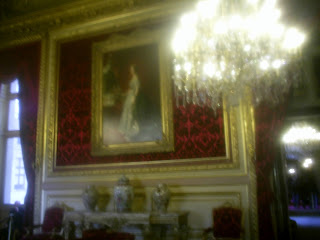We pass by the Musée Cluny almost every day as we walk down the Boulevard Saint Michel to get breakfast or lunch or as we make our way to our day's adventure. The Cluny holds tapestries, sculptures, stained glass, illuminated manuscripts and artifacts spanning over fifteen centuries. I believe this is my favorite museum. While it's not as mind-blowingly big as the Louvre or the Musée d’Orsay or even the Centre Pompidou, I like the almost cathedral-like quietness that some of the rooms have. I think I like it so much because it is dedicated to a period of particular interest to me, the Middle Ages. The modern world evolved from this era, and yet it is so different from our society.
I was surprised to see an illuminated manuscript that was not the Bible. Instead, the audio guide told a (probably exaggerated) story of Prince Gaston, who was the only legitimate heir of a French king, whose name I can’t recall. To solidify his claim to the throne, he asked his mother to return to court. When he could not convince her to do so, he procured a love potion from another member of the royal family. That way his mother and father would fall back in love and he would come back to court. However, Gaston did not know that he had been given poison instead. Luckily, his bastard brother figured out it was poison, but Gaston was thrown in the dungeon. There, Gaston refused to eat until he was released. The king went to visit him to try to understand what was going on. They argued and their fight escalated until the king was holding a knife to his heir’s throat. Then the king accidently sliced Gaston’s windpipe. The audio guide did not say what happened afterwards, but I guess they found another king.
One of the most beautiful rooms in the museum is the stained glass exhibit. They come from churches all over France and mostly depict Bible scenes, and tell the stories through pictures. The colors are so dark and rich, and while they lack dimension, they still have life.
Fragments of statues may not sound interesting, but I was entranced by the pieces from Notre Dame and other cathedrals. The ones I remember best were the heads of the Kings of Judah, with the worn paint still coloring the eyes and cheeks. The statues used to line the façade on Notre Dame, but Revolutionaries cut off they head, believing they belonged to French kings.
The most famous piece in the museum is The Lady and the Unicorn, a series of tapestries depicting a unicorn hunt. Five of the tapestries depict the senses of taste, hearing, sight, smell and touch. The sixth and last one shows the lady giving up worldly things, such as the five senses in order to be more devoted to king (represented by the powerful lion) and God (represented by the ethereal unicorn). The amount of work that the detail on the tapestries required is staggering. The animals and plants depicted range from local dogs to exotic monkeys. The lady’s dress and facial expression is different in every tapestry. Showing a picture of the tapestry would not do them justice, because they have to be seen.
























